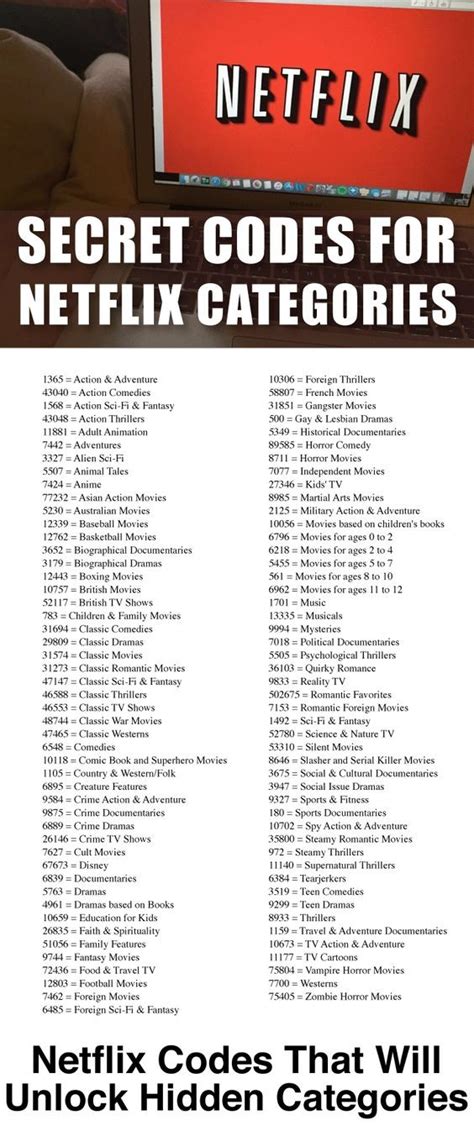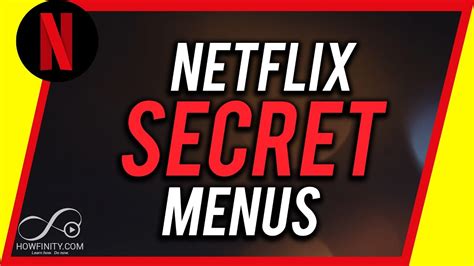
Tired of endlessly scrolling through Netflix with nothing to watch? Secret category codes can unlock a trove of hidden movies and shows tailored to specific genres and tastes, offering a solution for viewers stuck in a streaming rut.
Netflix’s algorithm, while powerful, doesn’t always surface the perfect viewing option. These codes, however, bypass the standard browsing experience, allowing users to delve into niche categories like “Critically-acclaimed Independent Movies” or “90s TV Comedies.” As reported by Yahoo Tech, “Netflix uses a complex algorithm to personalize recommendations, but sometimes it just doesn’t cut it.” The existence of these codes has been known for some time, but their utility in circumventing algorithmic limitations is now gaining renewed attention.
The core issue stems from the sheer volume of content available on Netflix. With thousands of titles spanning diverse genres, it can be challenging for viewers to find something that truly resonates. The standard browsing interface presents broad categories, but often fails to surface the hidden gems that cater to more specific preferences. This is where the secret codes come into play, offering a granular level of categorization that Netflix doesn’t typically expose to its users.
To access these hidden categories, users can simply enter a specific URL into their web browser: http://www.netflix.com/browse/genre/INSERTNUMBER. Replacing “INSERTNUMBER” with the appropriate code will direct the user to the corresponding hidden category. For example, the code “52858” unlocks the “Teen Screams” category, while “6548” leads to “Comedies.”
The discovery of these codes isn’t a new phenomenon, but their continuous relevance highlights the ongoing challenge of content discovery in the age of streaming. Netflix’s algorithm is designed to learn user preferences and provide personalized recommendations, but it’s not foolproof. Factors such as viewing history, ratings, and even time of day can influence the algorithm’s output, potentially leading to a narrow selection of recommendations.
“The codes offer a way to break free from the algorithm’s constraints,” according to a Yahoo Tech report. “They allow users to explore categories they might not otherwise encounter, potentially leading to the discovery of new favorites.” This is particularly useful for viewers with eclectic tastes or those seeking specific types of content that are not easily found through standard browsing.
The utility of these codes extends beyond simple entertainment. They can also be valuable for educational purposes, allowing users to easily access documentaries, foreign films, or historical dramas within specific sub-genres. For instance, the code for “Social & Cultural Documentaries” can provide a curated selection of films exploring various societal issues and cultural phenomena.
However, the use of these codes is not without its limitations. The codes are not officially supported by Netflix, and there is no guarantee that they will remain active indefinitely. Netflix may occasionally change or remove codes as it updates its content library and algorithms. Additionally, the codes only work when accessed through a web browser and are not directly accessible through the Netflix app on TVs or mobile devices.
Furthermore, the sheer number of codes available can be overwhelming. There are hundreds, if not thousands, of different codes covering a wide range of genres and sub-genres. Finding the right code for a specific interest may require some research and experimentation. Several websites and online forums have compiled lists of Netflix codes, but the accuracy and completeness of these lists may vary.
Despite these limitations, Netflix secret codes remain a valuable tool for viewers seeking to enhance their streaming experience. They offer a way to bypass the algorithm’s limitations, explore hidden categories, and discover new content that might otherwise go unnoticed. As long as the codes remain active, they will continue to provide a useful workaround for the challenges of content discovery on Netflix.
The popularity of these codes also underscores a broader issue in the streaming industry: the need for better content discovery tools. While algorithms have made significant strides in personalization, they are not always effective in surfacing the most relevant content for every viewer. As streaming libraries continue to grow, the challenge of content discovery will only become more acute, highlighting the need for innovative solutions that empower viewers to find what they’re looking for.
Netflix’s own efforts to improve content discovery include features such as personalized recommendations, trending lists, and “because you watched” suggestions. However, these features are still based on algorithmic analysis and may not always cater to the diverse and evolving tastes of individual viewers. The secret codes offer a complementary approach, providing a more direct and granular way to navigate the vast Netflix library.
The fact that viewers are actively seeking out and using these unofficial codes suggests that there is a demand for more control over the content discovery process. While Netflix is unlikely to officially endorse or integrate these codes into its platform, the company may need to consider incorporating similar features into its user interface to better meet the needs of its subscribers. This could involve allowing users to manually filter content by specific sub-genres, providing more detailed category descriptions, or offering more customizable recommendation settings.
In conclusion, Netflix secret codes represent a workaround for the limitations of algorithmic content discovery. While they are not officially supported and may not be a perfect solution, they offer a valuable tool for viewers seeking to explore hidden categories and discover new content. The continued popularity of these codes highlights the ongoing challenge of content discovery in the streaming age and underscores the need for more innovative solutions that empower viewers to find what they’re looking for. The codes provide targeted browsing, allowing users to unlock thousands of movies and shows they might otherwise miss, addressing the frustration of endless scrolling and potentially preventing subscription cancellations due to lack of engaging content. The codes essentially allow viewers to become their own curators, leading to more satisfying streaming experiences. The ability to bypass the algorithm provides a sense of control and discovery that enhances the overall value proposition of a Netflix subscription.
Furthermore, the use of these codes reveals a disconnect between the perceived value of Netflix’s expansive library and the actual ease of accessing it. While Netflix boasts a massive catalog of content, the effectiveness of that content depends heavily on the ability of users to find and engage with it. The secret codes serve as a bridge across this gap, enabling viewers to tap into the full potential of the Netflix library. They provide a means to circumvent the limitations of the algorithm and unlock a wider range of viewing options, transforming the streaming experience from a passive consumption model to a more active and exploratory one. This shift in user engagement can lead to increased satisfaction, prolonged subscriptions, and a greater appreciation for the depth and breadth of Netflix’s content offerings. The underlying issue highlighted by the prevalence of these codes is the need for Netflix to continually refine its content discovery mechanisms to better serve the diverse and evolving tastes of its subscriber base.
The phenomenon of “Netflix secret codes” underscores the critical importance of effective user interface (UI) and user experience (UX) design in the streaming landscape. While algorithms and personalized recommendations play a crucial role in guiding viewers toward relevant content, they are not always sufficient to meet the diverse needs and preferences of all users. The secret codes represent a workaround that allows viewers to exert more control over their viewing experience, effectively bypassing the limitations of the standard UI and accessing a more granular level of categorization. This highlights the need for streaming platforms to continuously iterate on their UI/UX design to provide more intuitive and customizable navigation options.
One potential solution could involve incorporating more advanced filtering and sorting capabilities, allowing users to narrow down their search results based on specific sub-genres, themes, actors, or directors. Another approach could be to provide more transparent and granular control over recommendation settings, allowing users to fine-tune the algorithm’s output based on their individual preferences. Furthermore, streaming platforms could explore alternative content discovery models, such as curated lists, user-generated playlists, or social recommendations, to complement the algorithmic approach and provide viewers with a wider range of viewing options.
By prioritizing UI/UX design and providing viewers with more control over their viewing experience, streaming platforms can enhance user satisfaction, improve content discovery, and ultimately foster a more engaged and loyal subscriber base. The “Netflix secret codes” phenomenon serves as a valuable reminder of the importance of continually innovating and adapting to meet the evolving needs and expectations of the streaming audience.
The implication of the Netflix secret codes also extends to content creators and distributors. The effectiveness of these codes in surfacing hidden gems suggests that many high-quality movies and shows are not receiving the visibility they deserve within the Netflix ecosystem. This can have a significant impact on the success of independent filmmakers, foreign language productions, and other niche content creators who may struggle to compete with mainstream Hollywood blockbusters. The secret codes provide a means for viewers to discover these underrepresented titles, but a more sustainable solution would involve Netflix actively promoting and curating a wider range of content within its standard user interface.
This could involve creating dedicated sections for independent films, foreign language dramas, or documentaries, or implementing more sophisticated recommendation algorithms that take into account the diversity of viewer preferences. Netflix could also partner with film festivals and independent distributors to showcase emerging talent and promote underrepresented voices. By actively supporting and promoting a more diverse range of content, Netflix can not only enhance the viewing experience for its subscribers but also contribute to a more vibrant and inclusive media landscape.
In addition to the content itself, the way in which content is presented and categorized can also have a significant impact on its discoverability. The secret codes highlight the limitations of the standard genre-based categorization system, which often fails to capture the nuances and complexities of individual movies and shows. A more effective approach would involve using more descriptive and granular tags to categorize content, allowing viewers to filter and search based on specific themes, moods, or narrative styles. This could involve tagging movies and shows with keywords such as “coming-of-age,” “psychological thriller,” or “social commentary,” allowing viewers to easily find content that aligns with their specific interests.
By implementing more sophisticated tagging and categorization systems, Netflix can not only improve content discovery but also provide viewers with a more nuanced and informed understanding of the content they are watching. This can lead to a more engaging and rewarding viewing experience, as viewers are better able to appreciate the artistic and thematic complexities of individual movies and shows.
The Netflix secret codes also raise important questions about the ethics of algorithmic curation and the potential for bias in personalized recommendations. While algorithms are designed to provide viewers with relevant content based on their viewing history and preferences, they can also perpetuate existing biases and limit exposure to diverse perspectives. For example, if a viewer primarily watches action movies, the algorithm may be more likely to recommend similar titles, potentially reinforcing their existing preferences and limiting their exposure to other genres or styles.
This can have a homogenizing effect on the viewing experience, as viewers are less likely to encounter content that challenges their assumptions or expands their horizons. To mitigate this risk, Netflix should strive to create algorithms that are more transparent, accountable, and inclusive. This could involve incorporating fairness metrics into the algorithm’s design, actively promoting diverse content, and providing viewers with more control over their recommendation settings. By addressing the ethical implications of algorithmic curation, Netflix can ensure that its recommendations are not only relevant but also fair and unbiased.
Ultimately, the success of Netflix and other streaming platforms depends on their ability to provide viewers with a compelling and engaging viewing experience. This requires a holistic approach that encompasses content acquisition, UI/UX design, algorithmic curation, and ethical considerations. The “Netflix secret codes” phenomenon serves as a valuable case study, highlighting the importance of continuously innovating and adapting to meet the evolving needs and expectations of the streaming audience. By prioritizing content discovery, personalization, and user control, Netflix can foster a more engaged and loyal subscriber base and ensure its long-term success in the competitive streaming landscape.
The use of VPNs (Virtual Private Networks) in conjunction with Netflix and these secret codes adds another layer of complexity to the equation. VPNs allow users to mask their IP address and appear to be browsing from a different country. This enables them to access Netflix content that is not available in their region. While Netflix has taken steps to block VPN usage, some users still find ways to circumvent these restrictions. The combination of VPNs and secret codes can potentially unlock an even wider range of content, as users can access hidden categories and titles from different regions around the world.
However, it’s important to note that using a VPN to access Netflix content may violate the company’s terms of service. Netflix has the right to terminate the accounts of users who are found to be circumventing regional restrictions. Additionally, the legality of using VPNs varies from country to country. In some countries, VPNs are legal and widely used, while in others they are restricted or prohibited. Users should be aware of the legal implications of using VPNs in their jurisdiction before doing so.
Despite these potential risks, the use of VPNs and secret codes remains a popular way for viewers to access a wider range of content on Netflix. This highlights the demand for more global content and the limitations of regional licensing agreements. As streaming platforms continue to expand their international presence, they may need to reconsider their regional licensing strategies to better meet the needs of their global subscriber base.
The implications of Netflix secret codes extend beyond the individual viewer and the streaming platform itself. They also have implications for the broader media industry, including film studios, television networks, and content distributors. The ability of viewers to access hidden categories and bypass algorithmic recommendations can disrupt traditional content distribution models and challenge the power of gatekeepers in the media industry.
For example, if a film studio invests heavily in marketing a particular movie, it may expect that movie to receive prominent placement on Netflix and other streaming platforms. However, if viewers are able to bypass the algorithm and discover other, less heavily marketed movies through secret codes, the film studio’s marketing investment may not yield the expected return. This can create a more level playing field for independent filmmakers and smaller studios who may not have the resources to compete with the marketing budgets of major Hollywood studios.
The rise of streaming platforms and the proliferation of content have already disrupted traditional media models, and the use of secret codes is just one example of how viewers are taking more control over their viewing experience. As the media landscape continues to evolve, it will be interesting to see how these trends impact the power dynamics between content creators, distributors, and viewers.
In the long term, the success of streaming platforms will depend on their ability to adapt to the changing needs and expectations of their subscribers. This requires a willingness to experiment with new content discovery models, embrace user control, and prioritize transparency and fairness in algorithmic curation. The “Netflix secret codes” phenomenon provides valuable insights into these challenges and opportunities, and it serves as a reminder that the future of streaming is in the hands of the viewers.
Frequently Asked Questions (FAQ):
-
What are Netflix secret codes? Netflix secret codes are numerical codes that, when entered into a specific URL in a web browser, unlock hidden categories of movies and shows on Netflix. These categories are often more specific than the standard genres presented on the platform’s main interface, allowing users to discover niche content.
-
How do I use Netflix secret codes? To use a code, type the following URL into your web browser:
http://www.netflix.com/browse/genre/INSERTNUMBER, replacing “INSERTNUMBER” with the specific code you want to use. This will take you directly to the corresponding hidden category. -
Are Netflix secret codes officially supported by Netflix? No, Netflix secret codes are not officially supported by Netflix. They are a workaround discovered by users to access hidden categories. Netflix may change or remove these codes at any time without notice.
-
Where can I find a list of Netflix secret codes? Numerous websites and online forums compile lists of Netflix secret codes. However, the accuracy and completeness of these lists may vary. It’s recommended to check multiple sources and verify the codes before using them.
-
Do Netflix secret codes work on the Netflix app? No, Netflix secret codes only work when accessed through a web browser. They cannot be directly used within the Netflix app on TVs, mobile devices, or other streaming devices.
-
Are there any risks associated with using Netflix secret codes? The primary risk is that the codes may become inactive or lead to unexpected results if Netflix changes its categorization system. There are no known security risks associated with using the codes themselves.
-
Why does Netflix have these hidden categories? Netflix uses a complex algorithm to personalize recommendations, and these hidden categories may be part of its internal categorization system. They allow for more granular organization of content, but are not all exposed to users through the standard interface.
-
Can using a VPN with secret codes get me banned from Netflix? Yes, using a VPN to bypass regional restrictions on Netflix may violate the company’s terms of service and could potentially lead to account termination.
-
Are Netflix secret codes a substitute for Netflix’s recommendation algorithm? No, they are a supplement. The secret codes offer a way to explore specific categories outside of the algorithm’s recommendations, but the algorithm still plays a crucial role in personalized content discovery.
-
How often does Netflix change or remove its secret codes? There is no fixed schedule. Netflix may change or remove codes periodically as it updates its content library and algorithms. Therefore, some codes may become inactive over time.
-
What if a secret code doesn’t work? If a secret code doesn’t work, it may have been changed or removed by Netflix. Try searching for updated lists of codes or exploring other related categories.
-
Do secret codes work for all Netflix regions? Some codes may be region-specific, meaning they only work in certain countries due to licensing agreements. Other codes may work globally.
-
Are there secret codes for specific actors or directors? While there may not be direct codes for specific actors or directors, you can often find categories related to their genres or types of films (e.g., “Films directed by Quentin Tarantino”).
-
Can I create my own Netflix secret codes? No, you cannot create your own Netflix secret codes. These codes are part of Netflix’s internal categorization system.
-
Is there a limit to how many secret codes I can use? There is no known limit to the number of secret codes you can use. You can explore as many categories as you like.
-
How do secret codes impact independent filmmakers and smaller studios? Secret codes can help surface hidden gems and underrepresented content, potentially giving independent filmmakers and smaller studios more visibility.
-
Does Netflix actively promote diverse content in its recommendations? Netflix’s algorithm aims to provide relevant recommendations, but it also faces challenges in mitigating bias and ensuring exposure to diverse perspectives. The secret codes offer a way to explore content outside of the algorithm’s typical suggestions.
-
What is Netflix doing to improve content discovery beyond its algorithm? Netflix is continuously experimenting with new features, such as personalized recommendations, trending lists, and “because you watched” suggestions, to improve content discovery. However, the secret codes highlight the need for more granular and customizable navigation options.
-
How do Netflix secret codes challenge traditional content distribution models? By allowing viewers to bypass algorithmic recommendations and access hidden categories, secret codes can disrupt traditional content distribution models and challenge the power of gatekeepers in the media industry.
-
What does the future hold for content discovery on streaming platforms? The future of content discovery will likely involve a combination of algorithmic personalization, user control, and innovative UI/UX design to provide viewers with a compelling and engaging viewing experience.









